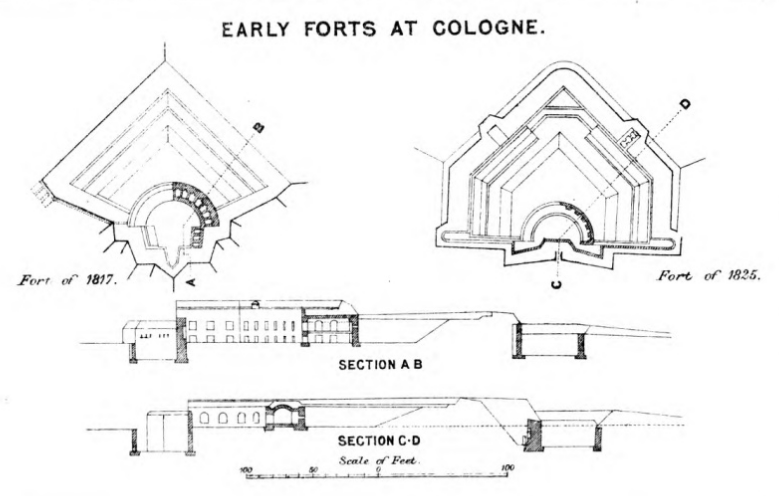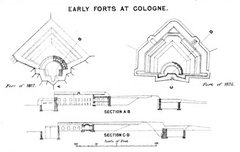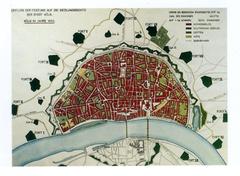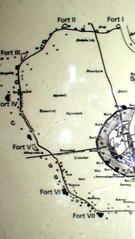
Visiting the Forts of Cologne, Germany: Tickets, Hours, and Tips
Date: 15/06/2025
Introduction to the Forts of Cologne
Cologne stands as a living testament to centuries of military architecture and urban resilience. From its Roman origins, through the grandeur of its medieval walls, to the innovative Prussian fort ring, Cologne’s fortifications embody the city’s strategic importance and cultural identity. Visitors can explore remnants of ancient city walls, majestic medieval gates, and 19th-century forts—many of which serve today as parks, museums, and cultural venues. Whether you are a history enthusiast, architecture buff, or curious traveler, this guide provides everything you need: historical context, visiting hours, ticket information, accessibility tips, and highlights of key sites (cologne-tourism.com; latlon-europe.com; audiala.com).
Table of Contents
- Introduction
- Roman Foundations and Early Fortifications
- Medieval Expansion and the Great City Wall
- Prussian Fort Ring and Modern Adaptations
- Key Sites: Hours, Tickets & Accessibility
- Visitor Tips and Practical Information
- Frequently Asked Questions (FAQ)
- Summary and Call to Action
- References
Roman Foundations and Early Fortifications
Cologne’s fortified history began with its establishment as Colonia Claudia Ara Agrippinensium (CCAA) in 50 AD. The Romans constructed robust city walls, towers, and gates to protect the settlement from Germanic tribes and assert imperial control in the region. Remnants of these fortifications are still visible today, including portions of the Roman city wall in the Old Town and the well-preserved Römerturm (Roman Tower), which boasts unique mosaic decorations (latlon-europe.com; cologne-tourism.com; audiala.com).
Another significant relic is the Ubier Monument, dating back to 5 or 6 AD, which marks some of the earliest phases of Cologne’s urban fortification. The Praetorium, once the seat of the Roman governor, is now an underground archaeological site open to visitors.
Visiting Hours & Tickets:
- Praetorium: Open Tuesday–Sunday, 10:00–18:00; tickets approx. €5 for adults.
Medieval Expansion and the Great City Wall
As Cologne flourished in the Middle Ages, it expanded its defenses to match its growing economic and political power. By the 13th century, the city boasted one of the largest city walls in Europe, stretching about 8 kilometers and punctuated by 12 monumental gates and over 50 towers. These fortifications were not only military structures but also symbols of civic pride, adorned with decorative reliefs and city emblems (latlon-europe.com; planetware.com).
Surviving landmarks include:
- Hahnentorburg: The ceremonial western gate.
- Eigelsteintorburg: The northern gate.
- Severinstorburg: The southern gate and a hub for city festivals.
- Ulrepforte: A fortified gate later converted into a defensive tower, associated with local folklore.
Visiting Hours & Tickets:
- Hahnentorburg: Tue–Sun, 11:00–19:00; €5 adults, children under 12 free.
- Eigelsteintorburg: Wed–Sun, 10:00–17:00; €4 entry.
- Severinstorburg: Daily, 09:00–20:00; free exterior access.
- Ulrepforte: Exterior viewable anytime; interior open during events.
Prussian Fort Ring and Modern Adaptations
In the 19th century, the Prussian administration constructed a ring of forts around Cologne (Festung Köln) to protect the city from invasion. Between 1816 and 1881, over a dozen forts—including Fort X (Neusser Wall), Fort XI (Riehl), and Fort IV—were built. Many have since been transformed into parks, museums, and community centers (cologne-tourism.com).
- Fort X: Features a rose garden; open daily from sunrise to sunset; free admission to gardens.
- Fort XI: Park area open year-round; free entry.
- Fort IV: Cultural venue; open during events.
Visitor Tip: Visit in late spring or early summer for the best experience in the rose gardens.
Key Sites: Hours, Tickets & Accessibility
| Site | Hours | Tickets | Accessibility |
|---|---|---|---|
| Römerturm | Daily 10:00–18:00 (exterior) | Free | Cobblestone street, Exterior |
| Hahnentorburg | Tue–Sun 11:00–19:00 | €5 adults | Wheelchair-friendly exterior |
| Eigelsteintorburg | Wed–Sun 10:00–17:00 | €4 | Restaurant accessible |
| Severinstorburg | Daily 09:00–20:00 (exterior) | Free | Wheelchair accessible |
| Ulrepforte | Exterior anytime | Free | Limited interior access |
| Fort X (Rose Grdn) | Daily sunrise–sunset | Free | Garden accessible |
| Malakoff Tower | Exterior anytime | Free | Near Rhine promenade |
Check event listings for occasional interior access and special exhibitions.
Visitor Tips and Practical Information
- Plan Your Route: Most medieval gates are within walking distance in the Old Town. Prussian forts are accessible by public transport or bike (cologne-tourism.com).
- Combine Attractions: Many gates are near other highlights such as Cologne Cathedral and the Rhine riverfront.
- Guided Tours: Walking and cycling tours are offered in several languages (latlon-guide.com).
- Accessibility: Most parks and exteriors are wheelchair accessible, but interiors may have stairs.
- Family Friendly: Many sites offer open spaces and seasonal events suitable for children.
- Events: Check for concerts, festivals, and open days, especially in May, June, and September.
- Best Time to Visit: Spring and summer for gardens and outdoor events; weekdays are less crowded.
Frequently Asked Questions (FAQ)
Q: What are the typical visiting hours for Cologne’s forts and gates?
A: Most exterior sites are accessible daily; interiors and guided tours operate on specific days and hours.
Q: Are tickets required?
A: Exterior viewing is generally free; interiors and events may require tickets (€4–€5 typical).
Q: Are the sites wheelchair accessible?
A: Parks and exteriors are mostly accessible; some towers have limited access due to stairs.
Q: Are guided tours available in English?
A: Yes, but advance booking is recommended.
Q: Can I visit with children?
A: Absolutely—many sites have parks and host family events.
Summary and Call to Action
Cologne’s forts and fortifications are more than historic landmarks—they are vibrant symbols of resilience, civic pride, and evolution. From Roman towers and majestic medieval gates to innovative Prussian forts, these sites offer immersive experiences for all visitors. With accessible hours, affordable tickets, and guided tours, Cologne’s fortified heritage is open to everyone. For the latest updates, interactive maps, and exclusive content, download the Audiala app or visit local tourism websites. Start your journey today and discover the stories that shaped Cologne’s remarkable cityscape.
References
- Exploring Cologne’s Fortifications: Visiting Hours, Tickets & Historical Sites Guide, 2025 (cologne-tourism.com)
- Cologne Fortifications History, 2025 (latlon-europe.com)
- Tourist Attractions in Cologne, 2025 (touropia.com)
- Cologne Historic Sites and Fortifications, 2025 (planetware.com)
- Visiting Cologne’s Historic Forts and Fortifications, 2025 (audiala.com)
- Discovering Cologne’s Hidden Gems, 2025 (explorial.com)
- Cologne Tourism Official Website, 2025 (cologne-tourism.com)








































































